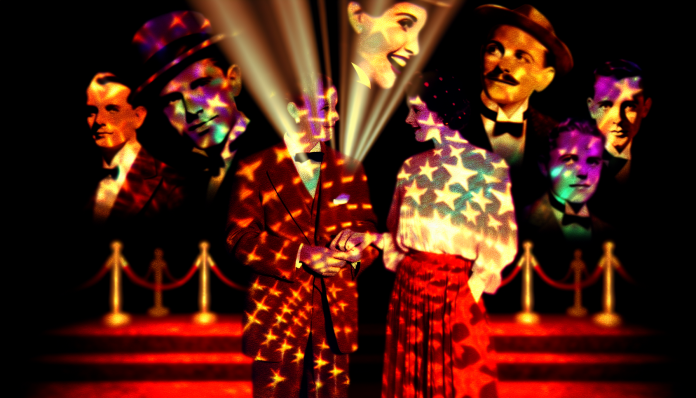Introduction
In the golden age of Hollywood, when glamour and stardom reigned supreme, Rock Hudson emerged as one of the most celebrated leading men. With his chiseled looks, suave charm, and memorable performances in films like All That Heaven Allows (1955) and Giant (1956), Hudson captivated audiences around the world. However, beneath the polished exterior lay a closely guarded secret that would send shockwaves through the entertainment industry and society at large — he was gay.
In the 1950s and 60s, homosexuality was largely stigmatized, categorized as a moral failing and even a mental illness by many. The societal norms of the time dictated strict guidelines around sexuality, especially for public figures like Hudson. His secret life would not only derail his personal relationships but also challenge the very fabric of Hollywood’s carefully constructed image.
The Scandal
Rock Hudson’s secret was an open one among those who knew him; however, the media and broader public maintained a facade of ignorance. In 1985, his illness became fodder for sensationalist headlines and tabloid discussions. Hudson’s diagnosis of AIDS — a disease that was poorly understood and heavily stigmatized at the time — came as a shock not just because of his celebrity status but because it came to light in an era when the LGBTQ+ community faced severe discrimination and fear.
It wasn’t until his public disclosure of his illness and his subsequent death in October 1985 that the truth about his sexuality was widely acknowledged. Hudson never publicly identified as gay during his lifetime; instead, he relied on a carefully constructed persona of heterosexuality, utilizing romantic relationships with actresses like Doris Day to further this narrative.
The announcement of his AIDS diagnosis in July 1985 was met with an outpouring of sympathy but also fear; the disease was frequently associated with the gay community, igniting homophobia and misconceptions. In what would later be described as one of the defining moments in the perception of AIDS, Hudson’s openness about his diagnosis brought the epidemic into the living rooms of millions, highlighting the urgent need for awareness and compassion in the fight against the disease.
Key Events and Public Reactions
- July 1985: Hudson publicly confirms his diagnosis, stating, “I’m not ashamed, I’m not afraid. I have AIDS.”
- October 2, 1985: Hudson passes away, prompting a global response that ranged from heartfelt tributes to heated debates about sexuality and HIV/AIDS.
- Societal Reaction: Notable public figures expressed solidarity, while others clung to prejudices, emphasizing the fear surrounding AIDS as a “gay disease”.
Quotes from the time reflected the stark divide in public sentiment. A USA Today article from 1985 featured a statement from medical experts emphasizing the need to view AIDS as a health crisis rather than a moral one, revealing how deeply rooted beliefs about sexuality informed public health responses.
Moral and Cultural Analysis
Response from Society
At the time, the media was mired in sensationalism, frequently reducing Hudson to a caricature that emphasized his sexuality rather than his talent. While some outlets offered sympathetic coverage, many highlighted his secret life with a sense of scandal. The pervasive stigma around AIDS, combined with Hudson’s celebrity status, ignited a dual narrative of vulnerability and vilification.
The consequences for Hudson were profound. He faced an internal struggle throughout his life, torn between his desires and societal expectations. Even in death, he continued to be scrutinized and objectified, making it difficult for his legacy to reflect his professional accomplishments.
A Modern Perspective
Fast forward to today, and the dialogue surrounding Hudson’s life and death presents a markedly different picture. LGBTQ+ rights have advanced significantly since the 1980s, and issues of sexual orientation and health are approached through a lens of empathy and inclusivity. Contemporary audiences are more likely to view Hudson’s life through the lens of tragedy and systemic failure rather than personal failure.
Social media has provided platforms for widespread advocacy and education, fostering supportive communities that reject outdated notions of stigma. Were a public figure like Hudson to come out today, it would likely be met with widespread support from both fans and fellow actors, illustrating how much societal norms have evolved.
- Key Differences in Contemporary Values:
- Inclusion: Celebration of LGBTQ+ identities rather than shaming.
- Awareness: Enhanced understanding of HIV/AIDS, with a focus on prevention and education.
- Acceptance: Greater acceptance in Hollywood and beyond, with many openly LGBTQ+ stars leading successful careers.
Conclusion
Rock Hudson’s secret life as a gay man in Hollywood reveals the complexities of navigating identity in a world that demands conformity. His story is not just one of personal struggle, but also a reflection of a society grappling with issues of sexuality, power, and the stigma that still lingers today.
As attitudes continue to evolve, Hudson’s legacy serves as both a cautionary tale and a source of inspiration. It challenges us to reflect on how societal values shape individual lives and to embrace a more compassionate understanding of the struggles faced by many in the LGBTQ+ community.
In contemplating Hudson’s life and the revolution surrounding his later years, we are encouraged to rethink our own perceptions of privacy, stigma, and identity. What can we learn from the past to create a more accepting future? The lessons of Rock Hudson’s scandal persist, reminding us that understanding and acceptance can pave the way for healing and change.

